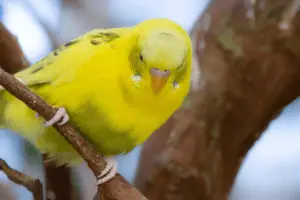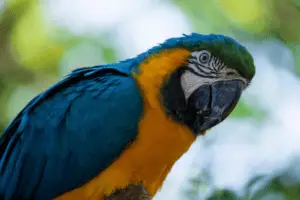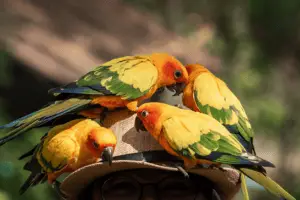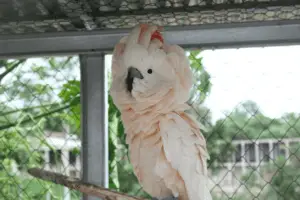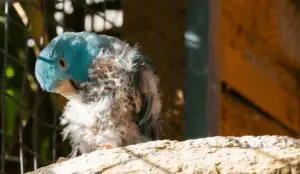Over the last few decades, parrot lovers have picked the different colorful Quakers over most parrot species for one main reason. And that’s not because they can match some of the enormous species available in size, but because of their beautiful colors. These birds are available in a wide range of colors; humans, particularly breeders, have played a major role in enhancing their beauty.
Thanks to rare genetic mutations and breeders, the planet has many monk parrot color variants. Breeders have produced cinnamon, yellow, blue, and white colored Quaker parrots through crossbreeding. In fact, the rare color mutations tend to be quite costly.
The wild type of monk parrots are naturally gray or green, but over the years, breeders have developed some rare beautiful parrots that range in color. These birds stand out and can help beautify your homes with their unique color combination and noises. So in this article, we’ll elaborate more on the many Quaker parrot colors.
What are Quaker Parrots?
Quakers are highly social and intelligent creatures loved worldwide for their beautiful colors. The Blue variant is among the most popular options in the United States. They were introduced in the country in the 1980s, and breeders fell in love with them. Their ability to learn to talk made parrot lovers pick them over cockatiels.
Compared to the African grey parrots, the Quakers are affordable and have a shorter lifespan. The lifespan will vary with the Quaker variant you purchase, contributing to its popularity.
What is the Original Color of Quaker Parrots?
The Quaker parrots, also known as Monk parakeets, are a true parrot species belonging to the Psittacidae family. They’re small-sized bright-green birds with greenish-yellow abdomens and greyish breasts with an average lifespan of between 20 and 30 years old. The wild ones have a pale gray forehead, dark blue remiges, and orange bills.
Their unique original color or wild-type coloration helps them hide from predators and prey in the wild. But over the years, breeders have developed different color variants of the Quakers, contributing to its popularity among parakeet lovers.
In the wild, they have bright green feathers covering their bodies, but you can find various color variants in captivity. Generally, domestic breeders have managed to breed Quakers in different colors, but the plumage remains the same. Some of the common color variants include replacing green with yellow, blue, and white.
But before we talk about the Quaker variants, including blue, the most popular option, we need to understand which colors our eyes are. Generally, we can distinguish between every color in the white light. So when something appears green, it means that it is absorbing the other colors in the white light spectrum to reflect green.
Generally, there are two genes that determine the color structure of your pet’s feathers. The structural gene develops unique prism-like structures that help reflect the blue colors from their feathers. The perfect combination of yellow-colored feathers and blue light makes your pet appear green.
The Most Common Quaker Parrot Colors
- Blue Quaker Parrot
The blue color is actually the second most popular Quaker color on the planet after green. The formation of the blue Quaker was a basic mutation that MJ Bruyneel achieved in the 1840s in Belgium. Other than the feathers, the other color that mutated was that of the plumage, which changed to green. This bird comes with a blue tint that’s noticeable after its 16th day on the planet.
The blue color is the outcome of mixing blue and yellow. The Blue Quaker is the most available and cheapest color mutation. It’s the outcome of crossbreeding of the original wild-type Quakers. After all, it is the first Quaker variant ever developed by breeders. They’re about 11 inches from the tail to their head and have a wingspan of about 14 cm. The females are about 20% smaller than the males. On top of that, the Blue Quaker is lighter than the original Green Quaker.
- Parablue Mutation
The parable mutation can trace its origin to the blue mutation. They’re the product of autosomal recessive mutation. This color came into existence in 1995 in the Netherlands and Belgium. In Canada and the UK, it came in 1999. It was introduced in Poland, the US, and the Czech Republic around 2011. This species underwent two color mutations (Aqua and turquoise):
- Aqua mutation: also referred to as sea-green mutation, is a popular Parablue Quaker variant. This process reduces the original Quaker’s green color by up to 50%, leaving it bluer. It is a lot bluer than the Turquoise mutation, and the color pattern on its plumage is uniform.
- Turquoise mutation: this process results in the reduction of the green color by 20%. With this mutation, the bird will have blue-green plumages. Unfortunately, the color of its plumage will be in patches. Unfortunately, it is greener than the Aqua mutation.
- Dark Green Mutation
Also referred to as fallow, this color mutation features similar genes as the Lutino mutation. The color of their plumage and claws is a bit lighter. In fact, it resembles a green parrot sprinkled with some yellowish mist. Their offspring have bright red eyes that darken as they mature, but the beak’s color remains unchanged.
- Grey-Green Colors
There are two types of grey-green colors; the ones from the US and the ones from Europe. These two mutations have undergone different mutation methods. The US mutation has darker green feathers and plumage than the Europe mutation, which comes with an olive-green tone.
The US grey-green mutation is a new mutation that Nelson Bob developed in Oregon in 2001 using some wild Quaker birds. On the other hand, the grey-green (Europa) was developed in the nineties in the Czech Republic. In no time, it became popular in Europe.
- Cinnamon Color Mutation
This Quaker color was achieved in the 1980s, and it comes with a unique cinnamon coating over the green feathers. The color of its feathers then changes from green or dark blue to cinnamon, creating a beautiful bird. Its claws are lighter, while it has dark plum eye color. And like most of the color mutations, the beak remains the same.
The original Cinnamon Quakers were imported from Argentina in 2002 by Mr. Favoreu Xavier, a popular Spanish breeder.
- White Quaker Parrots
This color mutation has been spotted in most of the world’s continents, including Asia, North America, Europe, and Africa. This color mutation is common in places with little to no sunshine.
- Lutino
This color mutation can be easily achieved via sex-linked recessive inheritance or autosomal. This type of mutation was first done in the 1840s in Berlin, but it disappeared. It then reappeared in the US in 1995. Lutino is one of the most beautiful color mutations available, featuring a unique color combination.
Yellow replaces the green color while the grey feathers on its breasts become yellow-white cream color. The color of its beak remains the same, while it has red eyes.
- Opaline Color Mutation
Opaline is the latest Quaker mutation that was developed by Mr. Favoreu Xavier in Europe in 2001. It then spread to other parts of the world, including Italy, Belgium, Netherlands, and Germany. Opaline color is quite rare and expensive; many people can’t get a hand on this mutation.
The green color is redistributed in the mutation process, creating a perfect mixture of yellow and green with some yellowish tinges. But the colors of their eyes, claws, paws, and beaks remain the same. Even the color of their feathers remains the same, with the main change being a white line that’s seen when they unfold their wings.
- Pallid Color Mutation
Another unique mutation is the pallid color that breeders created in the 1980s in Europe. Unfortunately, most folks confuse this mutation with the Cinnamon Quaker mutation.
The Pallid Quaker mutation has a soft yellowish coating on its bright greenish body. Luckily, the breast region, plumage, claws, and paws end up with a lighter tone. On the other hand, the darkest part of their body is their eyes which are dark red.
Other Common Quaker Colors
When it comes to color mutations, the possibilities are usually endless. Breeders have managed to create lots of color mutations; plus, some folks claim to have seen this bird in colors unknown to human beings. Some of its other colors include grey-green Opaline, grey-blue pallid, grey-green grey-blue Opaline, green pallid, cobalt-blue, cremini, and yellow face, among others.
Currently, even local small-scale breeders are experimenting with different Quakers, with their main goal being to attract more buyers. Therefore, you’re bound to get even more Quaker color options. It might be the reason why the Quaker colors matter a lot when it comes to this bird’s pricing.
Conclusion
Besides their unique personality, the Quakers are loved worldwide for their unique color variants. Since the Blue Variant was developed, breeders have been curious about its unique colors. So after doing some research, they learned that you could create other color variants, including parable, pallid, cinnamon, pied, and grey-green.
The latest color mutation is Opaline, which is rare and one of the costly options. But if you’re working with a tight budget, you should go for the Blue Quaker.
- Wikipedia contributors, Monk Parakeet, https://en.wikipedia.org/wiki/Monk_parakeet/ Accessed May 18, 2023
- Wikipedia contributor, Color Vision, https://en.wikipedia.org/wiki/Color_vision/ Accessed May 18, 2023
- YouTube contributors, Quaker Parrot Colors, https://www.youtube.com/watch?v=7yc7LVWMQWE&t=84s/ Accessed May 18, 2023
- YouTube contributor, About Blue Quaker Parrot, https://www.youtube.com/watch?v=xN5AwoiCHDA/ Accessed May 18, 2023
- YouTube contribution, Quaker Parrot Genetics – Breeding Combinations, https://www.youtube.com/watch?v=UNPtcMc7PpM/ Accessed May 18, 2023


